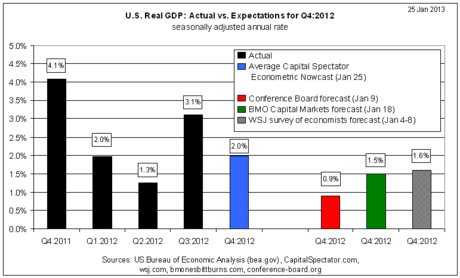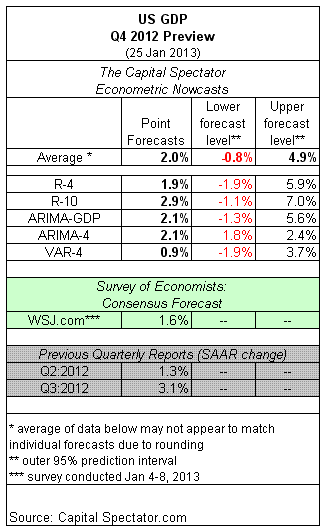Fourth-quarter U.S. GDP for 2012 is expected to increase 2.0% in next week's initial report from the government, according to The Capital Spectator's average econometric nowcast. That's up from the previous 1.6% nowcast published on January 7. The higher nowcast reflects several upbeat economic reports for December data that have been published over the last two weeks. The official Q4 data is scheduled for release on January 30, when the Bureau of Economic Analysis will publish its initial GDP estimate for the last three months of 2012. (All GDP percentage changes cited are quoted as real seasonally adjusted annual rates.)
In last year's third quarter, GDP advanced 3.1%, according to the current BEA estimate. Although the current 2.0% nowcast represents a substantial deceleration from Q3's pace, it's strong enough for expecting that the economy is on track to report a moderate rate of growth in the final three months of 2012. Note too that The Capital Spectator's 2.0% nowcast for Q4 GDP growth is above several recently published forecasts, including The Wall Street Journal's 1.6% consensus prediction via a January 4-8 survey of economists.

Here's a closer look at the individual nowcasts:
Here's a review of how the Q4 nowcasts have evolved since early November:
Finally, here's a brief profile for each of The Capital Spectator's nowcasts:
R-4: This estimate is based on a multiple regression in R of historical GDP data vs. quarterly changes for four key economic indicators: real personal consumption expenditures, real personal income less government transfers, industrial production, and private non-farm payrolls. The model estimates the statistical relationships from the early 1970s to the present. The estimates are revised as new data is published.
R-10: This model also uses a multiple regression framework based on numbers dating to the early 1970s and updates the estimates as new data arrives. The methodology is identical to the 4-factor model above, except that R-10 uses additional factors—10 in all—to nowcast GDP. In addition to the data quartet in the 4-factor model, the 10-factor nowcast also incorporates the following six series:
• ISM Manufacturing PMI Composite Index
• housing starts
• initial jobless claims
• the stock market (S&P 500)
• crude oil prices (spot price for West Texas Intermediate)
• the Treasury yield curve spread (10-year Note less 3-month T-bill)
ARIMA-GDP: The econometric engine for this nowcast is known as an autoregressive integrated moving average. This ARIMA model uses GDP's history, dating from the early 1970s to the present, for anticipating the target quarter's change. As the historical GDP data is revised, so too is the nowcast, which is calculated in R via the “forecast” package, which optimizes the prediction model based on the data set's historical record.
ARIMA 4: This model is similar to the ARIMA technique above in terms of the econometric application, but with a key difference. Instead of using historical GDP data as a lone input, the ARIMA 4 model analyzes four historical data sets to predict GDP: real personal consumption expenditures, real personal income less government transfers, industrial production, and private non-farm payrolls.
VAR-4: This vector autoregression model uses four data series in search of interdependent relationships for estimating GDP. The historical data sets in the R-4 and ARIMA 4 models above are also used in VAR-4, albeit with a different econometric engine. As new data is published, so too is the VAR-4 nowcast. The data sets range from the early 1970s to the present, using the "vars" package in R to crunch the numbers.
- English (UK)
- English (India)
- English (Canada)
- English (Australia)
- English (South Africa)
- English (Philippines)
- English (Nigeria)
- Deutsch
- Español (España)
- Español (México)
- Français
- Italiano
- Nederlands
- Português (Portugal)
- Polski
- Português (Brasil)
- Русский
- Türkçe
- العربية
- Ελληνικά
- Svenska
- Suomi
- עברית
- 日本語
- 한국어
- 简体中文
- 繁體中文
- Bahasa Indonesia
- Bahasa Melayu
- ไทย
- Tiếng Việt
- हिंदी
U.S. GDP: Q4 Update
Published 01/25/2013, 08:39 AM
Updated 07/09/2023, 06:31 AM
U.S. GDP: Q4 Update
3rd party Ad. Not an offer or recommendation by Investing.com. See disclosure here or
remove ads
.
Latest comments
Install Our App
Risk Disclosure: Trading in financial instruments and/or cryptocurrencies involves high risks including the risk of losing some, or all, of your investment amount, and may not be suitable for all investors. Prices of cryptocurrencies are extremely volatile and may be affected by external factors such as financial, regulatory or political events. Trading on margin increases the financial risks.
Before deciding to trade in financial instrument or cryptocurrencies you should be fully informed of the risks and costs associated with trading the financial markets, carefully consider your investment objectives, level of experience, and risk appetite, and seek professional advice where needed.
Fusion Media would like to remind you that the data contained in this website is not necessarily real-time nor accurate. The data and prices on the website are not necessarily provided by any market or exchange, but may be provided by market makers, and so prices may not be accurate and may differ from the actual price at any given market, meaning prices are indicative and not appropriate for trading purposes. Fusion Media and any provider of the data contained in this website will not accept liability for any loss or damage as a result of your trading, or your reliance on the information contained within this website.
It is prohibited to use, store, reproduce, display, modify, transmit or distribute the data contained in this website without the explicit prior written permission of Fusion Media and/or the data provider. All intellectual property rights are reserved by the providers and/or the exchange providing the data contained in this website.
Fusion Media may be compensated by the advertisers that appear on the website, based on your interaction with the advertisements or advertisers.
Before deciding to trade in financial instrument or cryptocurrencies you should be fully informed of the risks and costs associated with trading the financial markets, carefully consider your investment objectives, level of experience, and risk appetite, and seek professional advice where needed.
Fusion Media would like to remind you that the data contained in this website is not necessarily real-time nor accurate. The data and prices on the website are not necessarily provided by any market or exchange, but may be provided by market makers, and so prices may not be accurate and may differ from the actual price at any given market, meaning prices are indicative and not appropriate for trading purposes. Fusion Media and any provider of the data contained in this website will not accept liability for any loss or damage as a result of your trading, or your reliance on the information contained within this website.
It is prohibited to use, store, reproduce, display, modify, transmit or distribute the data contained in this website without the explicit prior written permission of Fusion Media and/or the data provider. All intellectual property rights are reserved by the providers and/or the exchange providing the data contained in this website.
Fusion Media may be compensated by the advertisers that appear on the website, based on your interaction with the advertisements or advertisers.
© 2007-2024 - Fusion Media Limited. All Rights Reserved.
